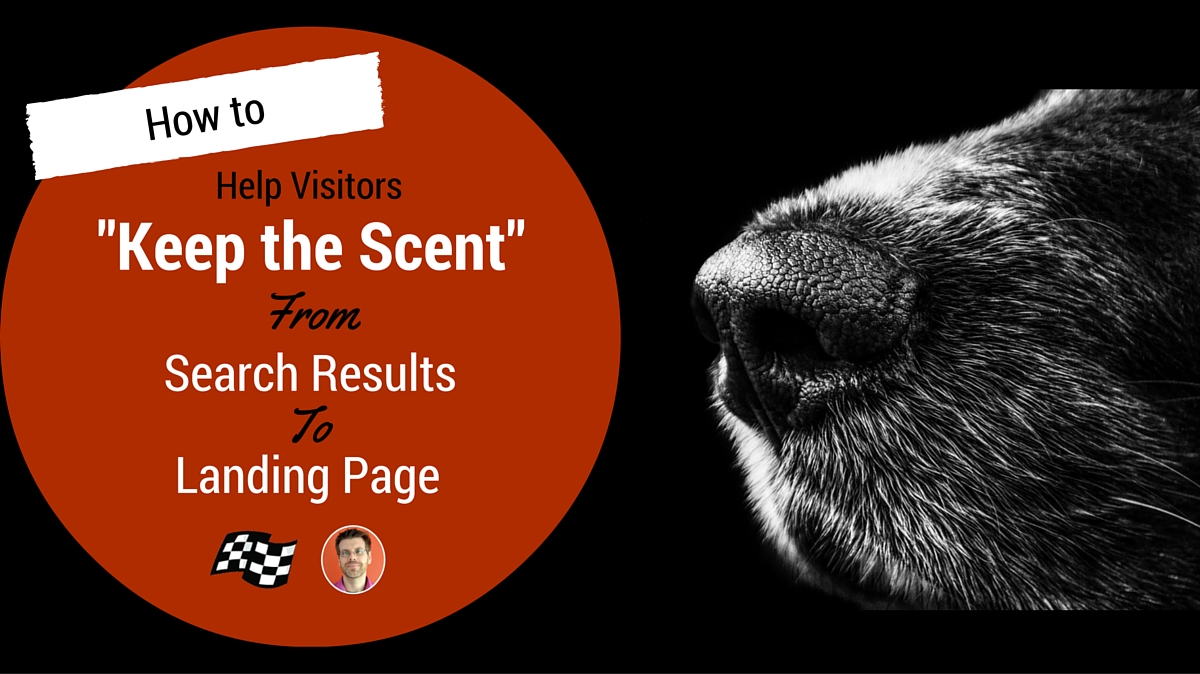
Getting searchers to click from search results to your website is a job well done–but not a job complete. There is still a lot more to do.
Searchers that click into your website are always in a hurry. They don’t want to take the time to figure out where they are or whether or not the page they landed on fulfills their needs. They just want to know. And if they DON’T know within a few seconds of landing on your site, they often leave. Your job is to do everything you can to confirm that the page they landed on is exactly what they were looking for.
That’s called keeping the scent from search results to site.
There was something about your search result that made them click. They have started down a path based on that scent. Now, you have to keep the scent by confirming that your page offers the solution they expect. Here’s how:
Clear Site Identification
One of the first things visitors see when they land on a page is the Site ID (logo). Your logo should be clear, clean, and obvious immediately upon landing on the page. It should also be surrounded by plenty of blank space to ensure it doesn’t get lost in a bunch of clutter.
It also helps if your logo (or accompanying tagline) provides some association with what the visitor needs. This goes back to your business name. It’s much more difficult to brand a random name than it is to brand a name that conveys what you do to some degree. If it’s too late to do that with the business name, make sure your tagline does the job.
Compelling Heading Tags
After the logo, visitors will often look to the heading text on the page. Content headings need to confirm the topic of the content that follows.
The topmost heading tag (which should be an H1–and the only H1 on the page) should provide a similar message as the page’s title tag. Where a title tag is limited to about 65 viewable characters, you have no limitations with your heading tags, other than the visual appeal and readbility. Use the H1 to reinforce the message of the entire page.
You can use additional headings to break up long content. Visitors will often scan content looking for particular answers or solutions and heading tags can help them do just that.
User-Focused Navigation
Another signal many visitors use to confirm they are on the right site the navigation. If the visible navigation is focused on your products or services, visitors will have no doubt that they landed on a page that is likely to meet their needs.However, if you hide your products and services under non-descriptive menu items, this scent will be completely unavailable.
Visitors should be able to know what you offer by looking at nothing else but your navigation. It should also be reinforced using relevant keywords that match what searchers use to find what you offer. Each navigation link can be a relevant keyword phrase that leads to a landing page for a specific solution.
Optimized Content
Your content goes beyond the scent and should fulfill the searchers’ needs completely. In fact, the content is the meal they’ve been sniffing along the way! Whatever searchers were looking for before and after they clicked, the content must deliver.
Use keywords as needed (and relevant) throughout the content, but stay focused on a single topic. Each web page should have a primary goal, and everything on the page should direct the visitor toward completing that goal.
Call the Visitors to Take Action
Never rely solely on your navigation to push visitors from one page to the next. Your content must contain clear calls-to-action and links that provide visitors with the opportunity to move on to the next stage in achieving their goal.
While each page may have one primary goal, not every visitor will be ready to pull the trigger, so to speak. It can be beneficial to provide some secondary goals with calls-to-action that will keep the visitor engaged on your site but through a less direct route to the goal.
To be effective, each call-to-action must be explicitly clear as to what the visitor will get when they click it. Don’t leave any guesswork, and certainly don’t allow for disappointment once they do click to the next page. Be sure the linked page is exactly what the linked content says it is.
Keep Them on YOUR Scent
When visitors perform searches, they have something very specific in mind. When they click on a link to your site, they do so believing that you have the solution they went searching for. They are on the scent, and it’s your job to keep them following that scent until they are satisfied. Just like a bloodhound, once visitors lose your scent, they’ll likely pick up another!
How to keep the scent
- Ensure your links in the search results match the intent of the search.
- Use a descriptive business name or tagline that makes what you do clear.
- Maintain the scent using relevant keywords and appropriate solutions throughout your content.
- Provide calls to action that drive visitors to the solution and give them a reason to finalize the deal.

 There was something about your search result that made them click. They have started down a path based on that scent. Now, you have to keep the scent by confirming that your page offers the solution they expect. Here’s how:
There was something about your search result that made them click. They have started down a path based on that scent. Now, you have to keep the scent by confirming that your page offers the solution they expect. Here’s how:
2 Responses to How to Help Visitors “Keep the Scent” from Search Results to Landing Page